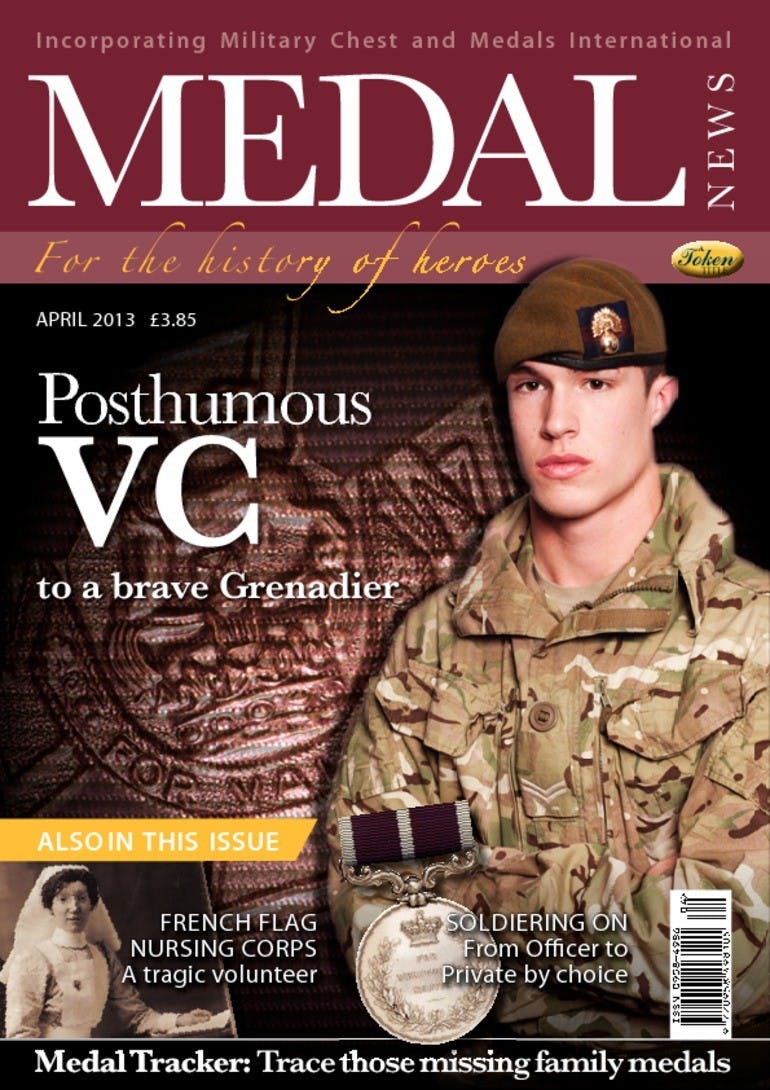Posthumous VC
Volume 51, Number 4, April 2013
Man or medal? THERE has been a debate on-line recently about medals vs men and what we as collectors should be researching and how we should be doing it. This is nothing new, it is a subject that has been brought up in conversations at medal fairs and medal clubs around the country on a regular basis for years, but I’m not entirely sure that I have covered it here. Essentially, the argument is whether we, as collectors, should be more interested in the recipient of the medal or the medal itself? In other words, are we just collecting good stories about brave men and women or are we more akin to coin and stamp collectors: collecting varieties of physical items? The arguments for the first type of collection are obvious—after all, without a man (or woman of course) there would be no medal, they had to have actually done something to be awarded that medal, be it an act of heroism, fighting in a campaign or a period of long service, but if we are simply collecting mementoes of service or heroism why is it that we don’t collect photographs? Or diaries? Surely these things are even more personal than the medals, aren’t they? Yes, many of us will eagerly search for a photo of “our man” or keep his diary with his group, but few of us would actively seek out such things were the medals not with them. We are medal collectors not ephemera collectors, but if we claim to be honouring the man then why don’t we collect ephemera? So if we are collectors of items rather than collectors of “stories”, why don’t we collect coins? Stamps? Banknotes? Why don’t we worry too much about condition? Why don’t we care overmuch if a medal has been repaired (as long as it is original) or if comes from a broken group? Yes of course these things do matter and when confronted by a medal that is in poor condition, or previously brooched, next to a similar one in pristine condition a collector will generally go for the latter, but they are not “deal breakers”, not factors that will stop a medal collector purchasing, whereas a coin collector would be horrified at being confronted by something in such poor shape! No, we are not numismatic collectors in that sense, but there are aspects to medals that are perhaps overlooked. It is relatively easy these days to “write up” your collection. Ancestry, Findmypast and similar websites, etc., have made finding the biographical details of recipients relatively easy and thus you can research your medals far more easily than at any point in history, but do you ever bother to research the medals themselves? Do you ever take more than a cursory glance at what suspension it has? What legend the obverse bears? What the naming style is and whether it differs from others issued? How many were awarded? What metal it is made from? I suspect the answer is no. Most of us will do the obvious checks for renaming or fakery but we won’t really do much in the way of in-depth research on the medal itself, we would rather research who it was awarded to—and that is reflected very much by the types of articles that we (and even research journals like the OMRS or JOMSA) receive every week. Is this because everything is already out there? Is there maybe no reason to do the research on the medal itself because it has all already been endlessly covered elsewhere? To a certain extent this is true—there’s little point in just regurgitating the information from great works of the past, but I do feel that somewhere out there there is still some original research to be done. So here is my challenge: if you want to write something for us we would be delighted to receive it, whatever its subject matter, but we would be especially delighted to receive some research work on the medals and not just the men behind them. It is great to read about Uncle Bill in the trenches. After all, the medals without the recipients are just lumps of metal, but conversely it would be good to learn a little bit more about those lumps of metal too. So next time you feel like writing about that trio why not look at things differently—why not start researching why there was a Star as the first campaign medal of World War I not a more accepted round medal? Why the colours of the ribbon of the British War Medal were what theywere? Why the Calcutta Mint named things in one style whilst the Royal Mint namedthem in another? Why the 1914 Star had battalion numbers on but the 1914-15 didn’t?There are dozens of topics to look at and whilst I will always maintain that the menare more important than the medal, there is, I think, room for some good research onthese funny little beribboned metal things. I can’t imagine it has all been said before can you . . .?
Order Back Issue
You can order this item as a back issue, simply click the button below to add it to your shopping basket.

